Varanasi
Varanasi, or Benaras, also known as Kashi is one of the oldest living cities in the world. Varanasi`s Prominence in Hindu mythology is virtually unrevealed.
Mark Twain, the English author and literature, who was enthralled by the legend and sanctity of Benaras, once wrote: "Benaras is older than history, older than tradition, older even than legend and looks twice as old as all of them put together"
Varanasi is a city on the banks of the Ganges in Uttar Pradesh, North India, regarded as the spiritual capital of India, is the holiest of the seven sacred cities in Hinduism and Jainism and played an important role in the development of Buddhism.
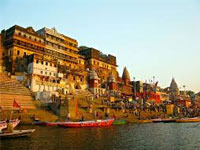
Varanasi is symbolized by its Ghats. Ghats in Varanasi are riverfront steps leading to the banks of the River Ganges. The spectacular 4 kilometer sweep of Ghats is a unique sight, best viewed at dawn, in that "soft first light" when the river and Ghats have a timeless appeal. Life is almost panoramic detail unfolds here from dawn to dusk as a steady stream of devotees-swelling to thousands on auspicious days –perform rituals by the Ganga. It is the Ganga Ghats of Varanasi that complement the concept of divinity. Ghats of Ganga are perhaps the holiest spots of Varanasi. The Ganga Ghats at Varanasi are full of pilgrims who flock to the place to take a dip in the holy Ganges, which is believed to absolve one from all sins.
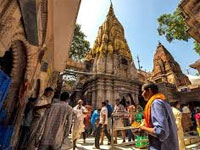
Also known as the Golden Temple, it is dedicated to Lord Shiva, the presiding deity of the city. Varanasi is Said to be the point at which the first jyotirlinga, the fiery pillar of light by which Shiva manifested has supremacy over others gods, broke through the Earth’s crust and flared towards the heavens. The Shivalinga installed in the temple remains the devotional focus of Varanasi. The Kashi Vishwanath temple is located in the heart of the cultural capital of India, Varanasi. It stands on the western bank of India's holiest river Ganges.The Jyotirlinga of Shiva, Vishweshwara or Vishwanatha, is enshrined in the Kashi Vishwanath temple, considered as one of the holiest temples of India. In Hindu religion it is believed that a simple glimpse of the Jyotirlinga is a soul-cleansing experience that transforms life and puts it on the path of knowledge and Bhakti (devotion).
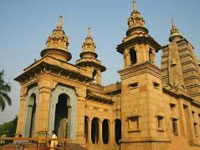
Sarnath has been a world famous Buddhist site in Varanasi. Lord Buddha preached his first sermon at a deer park in Sarnath. Sarnath is one of the four most important Buddhist pilgrimage centers of India. Buddha, the great sage , after attaining enlightenment (Buddha-hood) at Bodh Gaya came to Sarnath and delivered his first sermon to five disciples for redeeming humanity. It is this place where foundation of a new order of monks (Sangha) and a new order of religious doctrine (Dhamma) was laid. The inscriptions of early medieval period found from Sarnath referred to this place as Dharamchakra or Sadhamacharka pravartana vihar. Sarnath in Varanasi is one of the holiest site that attract people from all over the world. People visit Sarnath to pay homage to the great preacher Buddha and attain salvation. Some of the major monuments in Sarnath are Dhamek Stupa, Chaukhandi Stupa, Mulgandha Kuti Vihar, Ashoka Pillar, Bodhi Tree and Sarnath Museum. Archeological Survey of India is taking care of the ancient remains of rich collection of sculptures, artifacts and edifices comprising numerous Buddha and Bodhisattva images and other ancient remains excavated at Sarnath.
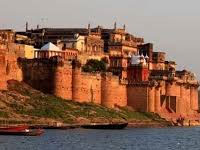
The residential place of Kashi Naresh (Former Maharaja of Varanasi) across the Ganges at Ramnagar houses a museum with the exhibits of palanquins, costumes, swords, sabres, etc. Dussehra celebration of Ramnagar is an interesting event to witness.14 km. from Varanasi. The fort at Ramnagar houses a museum displaying the Royal collection which includes vintage cars, Royal palkies, an armoury of swords and old guns, ivory work and antique clock. The Durga Temple and Chhinnamastika Temple are also located at Ramnagar. Ramnagar Fort which was built in 1750A.D by the Maharaja of Banaras, is on the right bank of River Ganga. Built of red stones, it provides strength and stability to the city.
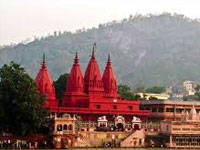
One of the popular temples of Varanasi, Durga Mandir is dedicated to Goddess Durga who is considered as the goddess of Strength and power and was built in the 18th century.It is believed that the Goddess appeared on its own in this temple in the form of a statue (murti) that is still there in the inner sanctum. It is also said that the Goddess protects and saves the sacred land of Benaras (Varanasi) since then. With a prominent North Indian style of architecture (Nagara style), stained in red and ochre, Durga Mata Temple has multi-tiered spires. The temple is known for its fine architecture and stone work. The temple also has a pond known as the Durga Kund that was earlier connected to the river via a channel that was closed later.
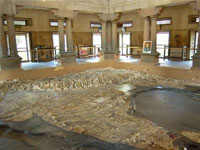
The Bharat Mata temple at Varanasi is the only temple dedicated to Mother India. It is located in the Mahatma Gandhi Kashi Vidyapeeth campus. The Bharat Mata temple was built by Babu Shiv Prasad Gupt and inaugurated by Mahatma Gandhi in 1936. The statute of Bharat Mata is built in marble and is a model of undivided India, depicting the mountains, plains and oceans. The most peculiar thing about the Bharat Mata Temple is that instead of the customary gods and goddesses, it houses a relief map of India, carved out of marble. It is inside the premises of Kashi Vidyapeeth.
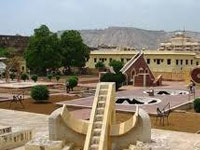
Jantar Mantar is an observatory, built by Jai Singh, the Maharaja of Jaipur in the year 1737. Jai Singh was a great admirer of science and technology and he was particularly passionate about astronomy. The Jantar Mantar was built to measure the local time, the Sun's declination, altitude, the declination of stars, planets and to determine eclipses The Jantar Mantar at Varanasi has several masonry instruments to record the motion, speed and properties starts and planets and study astronomy that are accurate and can still be used efficiently today. The Jantar Mantar incorporates multiple structures of unique form, each with a specialized function for astronomical measurement.These structures with their striking combinations of geometric forms have captivated the attention of architects, artists, and art historians.

Sankat Mochan temple is one of the sacred temples of Varanasi. It is located in the southern part of Varanasi, near the Banaras Hindu University. It is dedicated to the Hindu God, Hanuman. The word "Sankat Mochan" means one who helps in removing sufferings i. e. Lord Hanuman. Tulsidas, the author of the famous Hindu epic Ramacharitamanasa, founded the Sankat Mochan temple. According to Hindu mythology, one who visits the Sankat Mochan temple regularly, his wishes get fulfilled. The current temple structure was built in early 1900s by the educationist and freedom fighter, Pandit Madan Mohan Malviya, the founder of Banaras Hindu University.